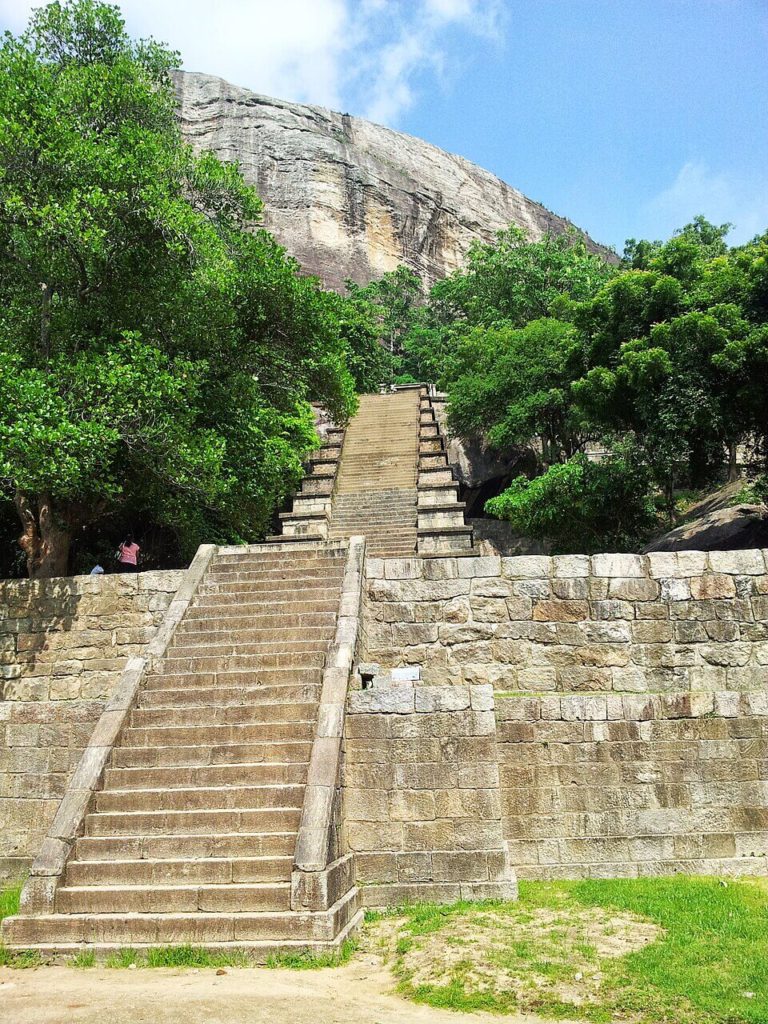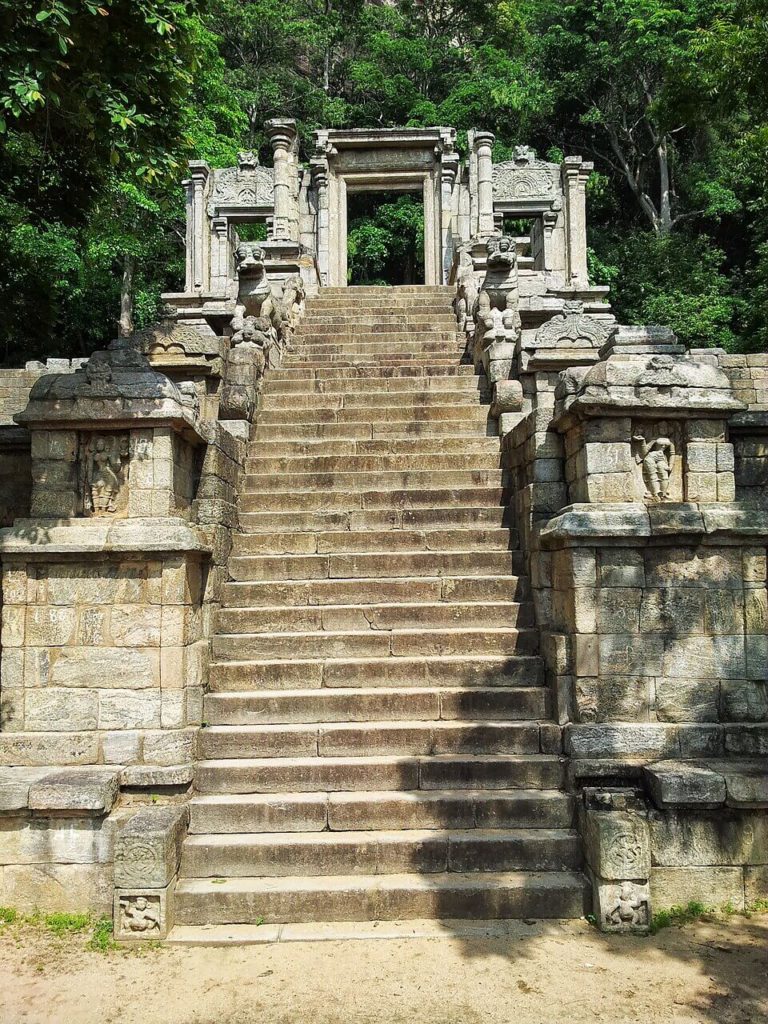Yapahuwa Rock Fortress: Climb to the Past

Yapahuwa Fortress, Sri Lanka.JPG” by Asiriu, via Wikimedia Commons — CC BY-SA 3.0.
⛰️ Why Go? Discovering the Lion’s Staircase
Imagine a fortress rising dramatically from the flat Sri Lankan plains, not as famous as Sigiriya, but every bit as magical. This is Yapahuwa, a massive rock outcrop that served as the capital of ancient Sri Lanka for a brief but glorious period in the 13th century.
It’s an open-air museum where you can literally walk through the ruins of a forgotten kingdom. The air is still and warm, filled with the scent of tropical flowers and the quiet chirping of unseen birds. Yapahuwa is less crowded than its more famous counterparts, meaning you get to explore its magnificent architecture—especially the iconic ornate stone staircase—in peace. For those who love history, this is where you can truly feel the weight of centuries beneath your feet.
☀️ The Travel Guide: Your Yapahuwa Adventure
Best Time to Visit
The best time to explore Yapahuwa is during the dry seasons, which run from January to March and May to September.
- The Weather Vibe: Expect plenty of sunshine! Visiting early in the morning (around 8:00 AM) or late in the afternoon is ideal. The rock can get very hot around midday, making the climb more challenging.
- The Green Factor: If you travel just after the rains (April or October), the surrounding landscape is at its most vibrant green, making for spectacular photos of the rock rising out of a lush, emerald jungle.
What to Do: Must-See Sights and Hidden Corners
- The Grand Staircase: This is Yapahuwa’s main event! It’s an incredibly steep, but absolutely stunning, stone staircase. Look closely at the sides and steps—they are guarded by magnificent carvings of lions, musicians, and dancers. Take your time here; this staircase is considered one of the finest examples of 13th-century Sinhala art.
- The Palace of the Sacred Tooth Relic: Halfway up the rock, you will find the ruins of the Temple of the Tooth. King Buwanekabahu I briefly housed the Sacred Tooth Relic of the Buddha here. Stand in the ruins and imagine the reverence and activity that once filled this elevated spot.
- The Cave Temple (Viharaya): At the base of the rock, there is an ancient cave temple with beautiful, faded frescoes dating back to the Kandyan era (18th century). It’s a quiet, cool spot and a wonderful place for reflection.
- The Royal Citadel Ruins: Walk around the massive, crumbled walls at the base. You can still see the remains of the moat, the outer walls, and the inner protective walls that once defended the city.

Getting Around
Yapahuwa is located in the North Western Province, about 4-5 hours by road from Colombo.
- Budget Option (Train/Bus): You can take a train or bus toward the Kurunegala or Maho area and then catch a local bus or tuk-tuk to the fortress. This is the most authentic, budget-friendly way but takes the longest.
- Comfort Option (Private Car/Driver): For first-time travelers, hiring a car and driver is often the easiest and most comfortable option. They can take you directly to the site, wait for you, and often share local knowledge along the way. This allows you to combine Yapahuwa with other sites like the Anuradhapura or Polonnaruwa ancient cities.
- On-Site: The rock fortress area is easily walkable once you arrive. You simply walk from the base ruins toward the central staircase and climb up.
Travel Tips: Connecting with the Culture
- Dress Respectfully: While Yapahuwa is a fortress, it also contains sacred temple ruins. When exploring the base or the Temple of the Tooth site, it is polite to wear clothing that covers your shoulders and knees.
- Bring Water and a Hat: The climb, even to the main staircase, is exposed to the sun. Stay hydrated!
- The Climb: The final few steps of the main staircase are extremely steep and have no handrails. Don’t worry! Local guides often stand near the top to offer a steadying hand. Climb slowly and use your hands for balance. It’s totally worth the view!

📜 Cultural Echoes: History and the Lion
Hidden Histories & Old Stories
Yapahuwa was established as the capital in 1273 AD by King Buwanekabahu I. The name Yapahuwa is thought to be derived from the Sinhala word yapa, meaning a “viceroy” or “secondary ruler,” and pabbata, meaning “rock.” It literally means “The Rock of the Viceroy.”
The kingdom only lasted for about 14 years before it was invaded. This short period of rule is what makes the architecture so distinct. The grand staircase, for example, is famous for the carving of a life-sized, fearsome lion (Sinhaya) that once stood guard at the top. Though the original lion is now housed in the Colombo National Museum, the replica and the spirit of the lion still stand sentinel over the steps. This lion is a powerful symbol of the Sinhala people’s heritage.

Past Travelers’ Stories
Imagine traveling here centuries ago! After the capital was moved, Yapahuwa largely became overgrown jungle. European explorers in the 19th century were astonished to find the ruins, calling the great staircase a marvel of ancient engineering.
One early traveler wrote of “the perfect preservation of the stone steps, despite the jungle reclaiming all else.” They were struck by the sheer scale of the ruins, noting that the kings of Yapahuwa had built their stronghold to be both impregnable and beautiful.

🌟 Final Thought: A Step Back in Time
Yapahuwa is a journey not just to an archaeological site, but to a vivid, though brief, chapter of Sri Lankan history. It offers the thrill of a good climb and the quiet reward of standing where a king once stood, gazing out over a timeless landscape.